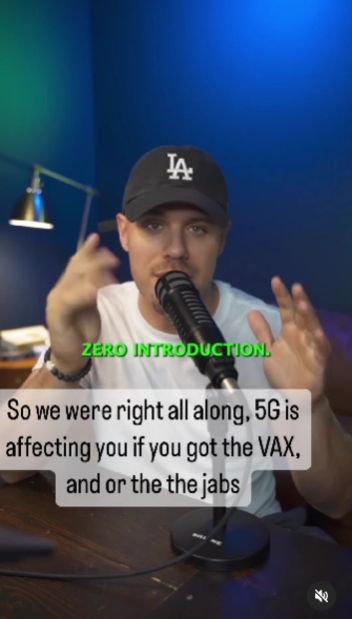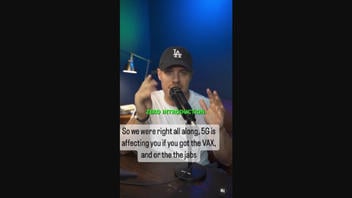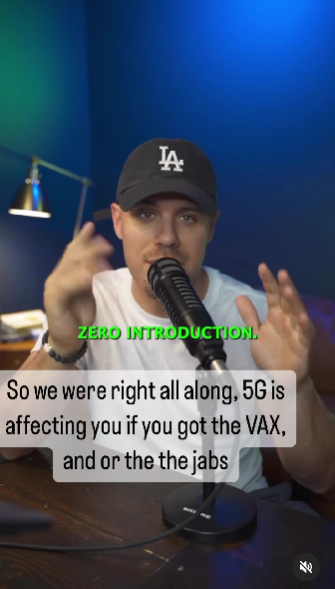

Does a patent prove that Moderna's mRNA COVID-19 vaccines contain nanotechnology that interacts with 5G? No, that's not true: There is no evidence that mRNA vaccines or their contents interact with 5G technology, a molecular biologist told Lead Stories. A chemical engineer confirmed this, saying there is "absolutely no evidence at all" that such claims are true and that "there is nothing in the mRNA vaccine that should interact in any way with 5G technology."
An authentic July 2020 patent that describes mRNA technology was misrepresented in a video compilation shared on Instagram on July 25, 2023. The video also included misinterpreted language from a genuine article published by the American Chemical Society. Together, these items were falsely portrayed as evidence that proved mRNA vaccines interact with 5G technology.
A version of the claim originated in a video (archived here) on Instagram on July 25, 2023. The post's caption and a video graphic read:
So we were right all along, 5G is affecting you if you got the VAX and or the the jabs
Below is how the post appeared at the time of the writing of this fact check:
(Source: Instagram screenshot taken Tues July 25 21:14:00 UTC 2023)
An unidentified person in the above video says:
So, let's just get into this and I'd like to take you through the patents that are on Moderna's website. So, there's a patent entitled, 'Modified Polynucleotides for the Production of Secreted Proteins.' This is one of the master patents for what they're calling mRNA vaccines. Right in the abstract, it describes that the lipid nanoparticles have a particle size between 80 and 160 nanometers, and it contains modified mRNA encoding a polypeptide. It includes a cationic lipid, a neutral lipid, a cholesterol, and a pegylated lipid. What they're calling lipids actually host cationic charges. They host positive electromagnetic fields. There is no lipid in nature that does that. They're using the term lipid instead of nanotechnology.
As you go through the patent in section 219, it explains how they are self-assembled nanoparticles and they're fully programmable. That term in here is -- it is an alarming term for a number of reasons. One reason is that these are both pre-programmable as well as they can receive programs from an external source.
Two experts who are not affiliated with Moderna or the development of this patent independently confirmed to Lead Stories that claims that suggest Moderna mRNA COVID vaccines contain nanotechnology that interact with 5G technology are not true.
As of July 2023, 5G (fifth generation) is the newest version of telecommunication technology that delivers higher data transmission, according to the Federal Communications Commission. Lead Stories searched the 248-page Moderna patent for language that might indicate any relation to 5G technology, including the following terms: 5G, broadband, network, download, phone, transmitter, receiver, battery, power source and antenna. We did not find a single reference.
Chemical engineer Andrew Zydney, a professor at Penn State College of Engineering with expertise in vaccine technology, told Lead Stories in an email received on July 27, 2023, that there is "absolutely no evidence at all" that such claims are true, and that "there is nothing in the mRNA vaccine that should interact in any way with 5G technology."
The patent does not reflect new technology presented in 2023, as the Instagram post implies. Rather, it's a continuation of patent applications and technology related to mRNA vaccines that have been in development since at least 2013.
Lead Stories found the patent referenced in the video, US 10,703,789 B2, on the Moderna website. It is titled "MODIFIED POLYNUCLEOTIDES FOR THE PRODUCTION OF SECRETED PROTEINS" and was published on July 7, 2020. Its abstract read, in part:
A pharmaceutical composition which has a plurality of lipid nanoparticles that has a mean particle size of between 80 nm and 160 nm and contains a modified mRNA encoding a polypeptide. The lipid nanoparticles include a cationic lipid, a neutral lipid, a cholesterol, and a PEG lipid.
The patent describes ways of chemically modifying naturally occurring RNA to enhance its ability to provide a desired biological response. In the case of a vaccine, this is the generation of an immune response specific to the protein encoded by the RNA, Zydney told Lead Stories.
'Lipids' and 'nanotechnology' are not synonymous terms to be used interchangeably
The video's narrator misrepresented the context and meaning of the patent's actual language. For example, the person in the video falsely implied that the terms "lipids" and "nanotechnology" are synonymous and used the two terms interchangeably.
"Nanotechnology refers to any technology that involves components that have length scales on the order of nanometers," Zydney explained. "Nanotechnology is at the heart of the computer chips we use (in almost everything) since the size of the transistors used in these chips is currently just a few nanometers."
A human hair, for example, is between 50,000 and 100,000 nanometers thick, according to the Australian Academy of Science.
On the other hand, lipids are a specific class of organic molecules that are insoluble in water. Human cells are surrounded by a membrane made from lipids. Since a lipid is quite small -- often between one and 10 nanometers -- technology based on the behavior of lipids is considered nanotechnology.
'Self-assembled' and 'fully programmable' nanoparticles can't be externally programmed
Similarly, the person in the video stated that "self-assembled" and "fully programmable" nanoparticles are "alarming" because they can "receive programs from an external source."
Michael Imperiale, a molecular biologist at the University of Michigan Medical School who is not affiliated with the patent, told Lead Stories in an email received on July 27, 2023, that this process is not possible.
"Self-assembled means if you mix the lipids and RNA, they come together to form the nanoparticles without any other components. Fully programmable here does not mean in the sense we normally think about [with] computers. It means by changing the properties or type of lipid, one can change the physical properties of the nanoparticles," he said.
A lipid is a fatty compound that performs a variety of functions in the body, including moving and storing energy, absorbing vitamins and making hormones, the Cleveland Clinic explains. "Self-assembled nanoparticles" simply means that the lipids that are used in the vaccines naturally assemble themselves into very small particles.
"For example, when our bodies make proteins, the chain of amino acids naturally folds (or assembles) into a well-defined 3-dimensional structure. When you have a salt-water solution and evaporate the water, the salt naturally assembles into well-defined salt crystals. In all of these cases, the self-assembly is driven by the interactions between the component parts," Zydney told Lead Stories.
In the context of this patent, "fully programmable" means that the lipid nanoparticles can be designed so that they behave in a specific way. This behavior is programmed into a lipid nanoparticle through various characteristics, such as its size or charge. Zydney added that many medications employ a similar concept of programming, such as tablets that are designed to release drugs immediately, while others may do so over longer periods of time (such as extended-release).
"You simply change the properties of the tablet to 'program' the desired behavior," said Zydney.
Cationic lipids do not create electromagnetic fields
In the video shared on Instagram, the person stated that "There is no lipid in nature that does that," meaning "host positive electromagnetic fields." The individual was referring to an article in Chemical & Engineering News from the American Chemical Society. The article, published on March 6, 2021, actually cited a University of British Columbia nanoparticle scientist as saying, "There are no cationic lipids in nature."
If a lipid is cationic, it means that it contains a positive charge when in solution. Most lipids in the human body are anionic, which means that they are negatively charged. There isn't anything particularly unusual about molecules that become positively charged when put in water, Zydney said.
Lead Stories has also reported that there is no proof 5G causes nosebleeds, cancer in the brain, low sperm count, headaches or insomnia, that a video showing the insides of two 5G phones does not prove the technology does not exist in Canada and that the National Institutes of Health did not admit 5G can actually create coronavirus within human cells.

















